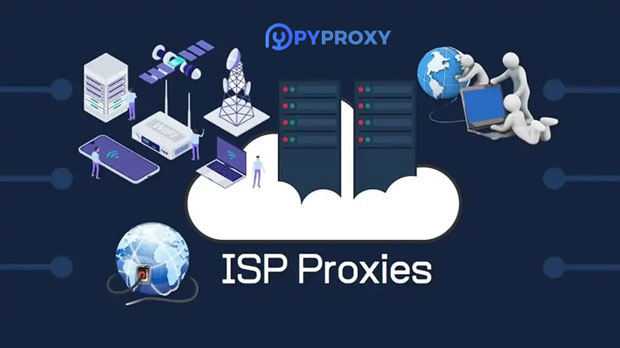Luminati VS pyproxy: Advantages and Disadvantages of Static Residential Proxies for Dynamic IP Switching
In today's digital landscape, web scraping, online anonymity, and automated browsing require efficient and reliable proxy solutions. Among the various types of proxies, residential proxies play a vital role, especially when dynamic IP switching is essential for tasks like market research, competitive analysis, or bypassing geo-restrictions. Luminati and PYPROXY are two popular providers offering static residential proxies with dynamic IP switching capabilities. However, each solution has its own strengths and weaknesses, particularly when it comes to managing IP rotation and ensuring seamless connectivity. This article provides a comprehensive analysis of how these two services compare in terms of performance, reliability, and scalability in dynamic IP switching. Introduction to Static Residential Proxies and Dynamic IP SwitchingResidential proxies are IP addresses that are assigned to real residential devices and are used by proxy providers to route traffic. Static residential proxies, in particular, are associated with a fixed IP address that stays the same for a longer duration but can still provide the advantages of residential IPs, such as avoiding detection by websites and bypassing geo-restrictions.Dynamic IP switching refers to the process of changing the IP address during a browsing session, which can be critical for avoiding blocks, CAPTCHA challenges, and other restrictions while browsing websites at scale. In both Luminati and Pyproxy's case, their services allow users to rotate or switch IPs, but how efficiently they do this—without compromising connection quality, speed, or reliability—makes all the difference.Overview of Luminati and Pyproxy ServicesLuminati, now known as Bright Data, is a well-established player in the proxy service industry, offering a vast network of residential proxies. It supports dynamic IP rotation, enabling users to seamlessly switch IPs without losing connection or session data. On the other hand, Pyproxy, while relatively newer, has been gaining attention due to its focus on performance and flexibility in handling proxy tasks, including dynamic IP rotation.While both services claim to offer static residential proxies, there are subtle differences in how they handle dynamic IP switching, network scalability, and ease of use. To provide a clearer picture, let's explore these differences in more detail.Performance and SpeedWhen it comes to dynamic IP switching, one of the key factors influencing the user experience is the performance and speed of the proxy network. A proxy that switches IPs too frequently or too slowly can cause delays, timeouts, or disruptions in services.Luminati has a large and diversified pool of IP addresses, which helps maintain a consistent connection even with dynamic IP rotation. However, the performance can sometimes vary depending on the geographical location of the IP addresses and the level of congestion within their network. The proxy speeds are generally reliable, but users in remote regions may experience slightly reduced performance due to fewer available nodes.Pyproxy, on the other hand, focuses on maintaining high speed and low latency by using a smaller but more specialized pool of residential IPs. This allows for better performance in specific regions, especially for tasks that require fast rotations and minimal downtime. However, the smaller pool means there may be limitations when scaling operations, and it might not offer as wide coverage as Luminati in some locations.Reliability and StabilityFor businesses and users relying on proxies for scraping or browsing at scale, reliability is critical. Proxies that drop connections or face frequent failures can disrupt workflows and lead to wasted resources.Luminati, with its extensive infrastructure and robust network, generally provides excellent reliability. Its large pool of residential IPs ensures that the proxy network remains stable even with dynamic IP switching. However, users might occasionally experience issues related to IP quality, especially if the rotation algorithm is not well-tuned for the specific task at hand.Pyproxy, by contrast, places a premium on maintaining stable and uninterrupted connections. While its pool of IPs is smaller, it is designed for high uptime, offering a more consistent experience for users engaged in tasks that require fewer but more reliable IP rotations. However, its smaller IP pool means that users might run into issues with availability if many users are accessing the same set of IPs.Ease of Use and FlexibilityEase of use plays a pivotal role in determining how quickly users can integrate a proxy service into their workflow. Both Luminati and Pyproxy provide user-friendly interfaces and documentation, but the complexity of setup and configuration can differ.Luminati offers a more feature-rich platform with greater flexibility in managing IP rotation and integrating proxies into a variety of tasks. While this flexibility is an advantage, it may come with a steeper learning curve for new users. Setting up dynamic IP switching requires familiarity with the platform’s API, and users may need time to optimize their configurations for maximum efficiency.Pyproxy, in contrast, focuses on simplicity and ease of integration. Its setup process is more straightforward, which can be an advantage for users who need to get up and running quickly. However, this simplicity can sometimes come at the expense of advanced configuration options. Users looking for highly granular control over their IP switching may find Pyproxy less flexible than Luminati.Scalability and CoverageScalability refers to how well a proxy service can handle a growing number of requests or the expansion of proxy use across regions. This is particularly important for businesses that need to scale their operations over time.Luminati excels in scalability, thanks to its vast network of IP addresses across various geographic regions. With over 72 million IPs to choose from, it can easily accommodate large-scale scraping, market research, or SEO tasks, even when switching IPs dynamically. This vast network also ensures that users can maintain access to high-quality IPs regardless of location, which is essential for large-scale operations.Pyproxy, with its more focused pool of IP addresses, may struggle with scalability when compared to Luminati. While it offers good coverage in certain regions, its smaller network may limit the ability to scale for large-scale operations or to reach remote regions. Users with modest proxy needs will find Pyproxy adequate, but those needing extensive coverage may face limitations.Pricing and Value for MoneyPricing plays a key role in the decision-making process, especially for businesses looking for a cost-effective solution. Luminati’s pricing tends to be on the higher end due to the extensive network and premium features it offers. However, it provides considerable value in terms of performance, scalability, and reliability.Pyproxy, while offering lower prices, may not always deliver the same level of performance or scalability as Luminati. The smaller pool of IPs and the focus on specific regions means that users may get better value for money if their needs align with Pyproxy’s strengths.ConclusionWhen comparing Luminati and Pyproxy for dynamic IP switching with static residential proxies, both services offer unique advantages and limitations. Luminati stands out for its vast network, scalability, and reliability, making it an ideal choice for large-scale operations. However, the complexity of its platform and higher pricing may make it less appealing for smaller users.On the other hand, Pyproxy offers a more cost-effective solution with simpler setup and more reliable performance in specific regions, but its smaller network and limited scalability may pose challenges for users with larger or more diverse needs.Ultimately, the choice between Luminati and Pyproxy depends on the specific requirements of the user, including the scale of operations, geographical coverage, performance demands, and budget. By carefully considering these factors, users can make an informed decision to select the most suitable service for dynamic IP switching and static residential proxies.
2025-02-28

























































